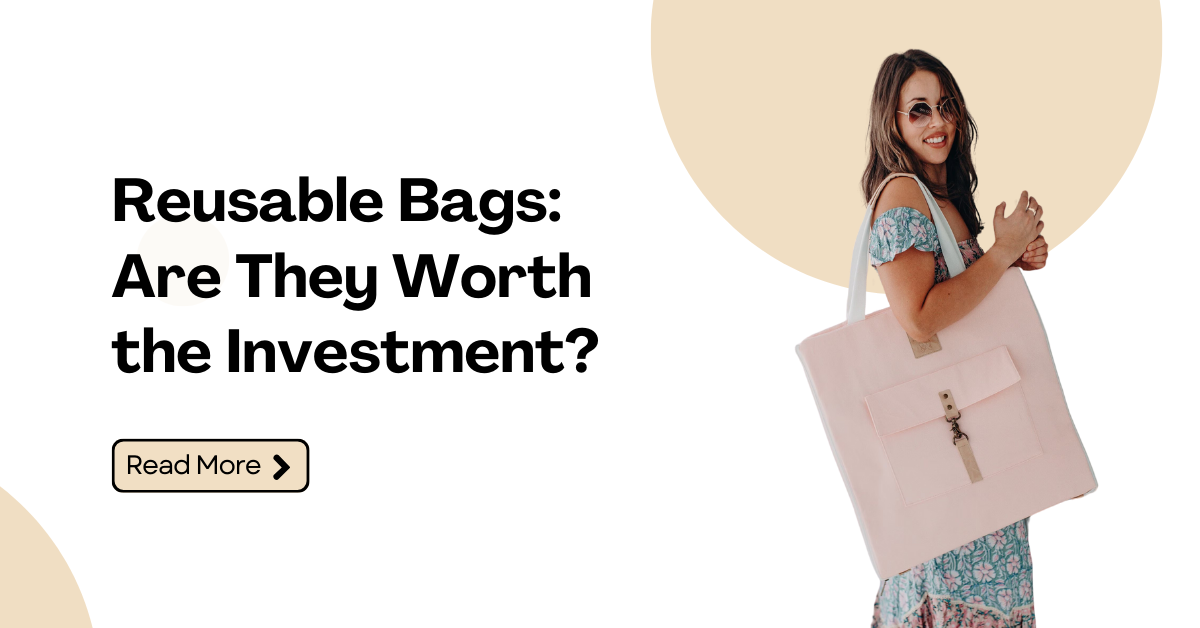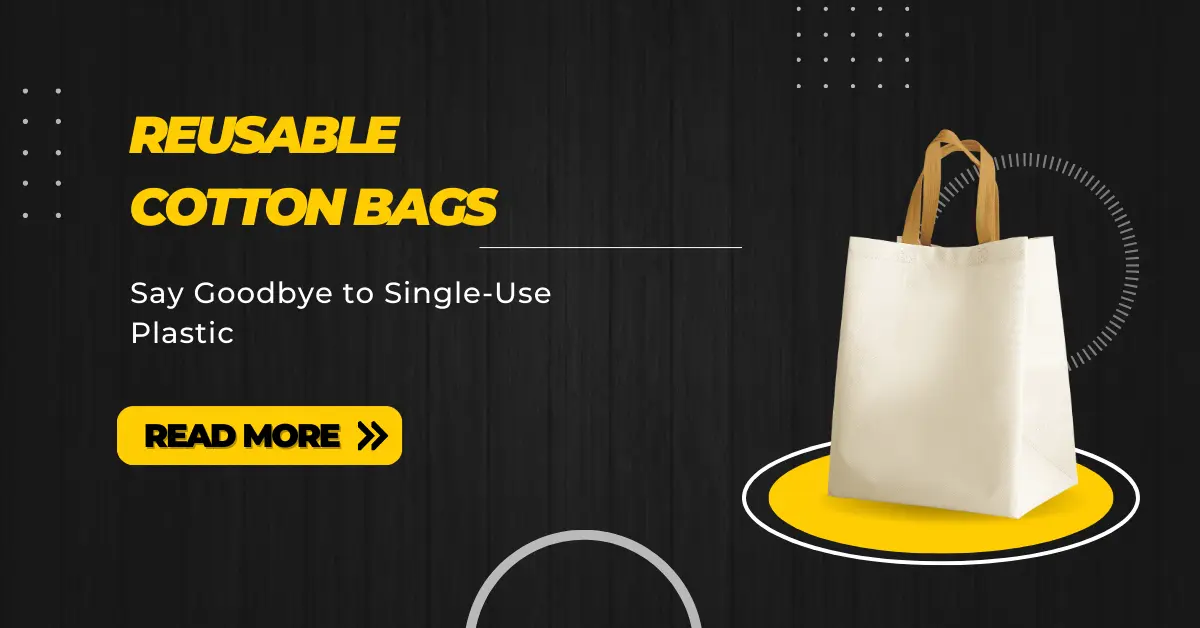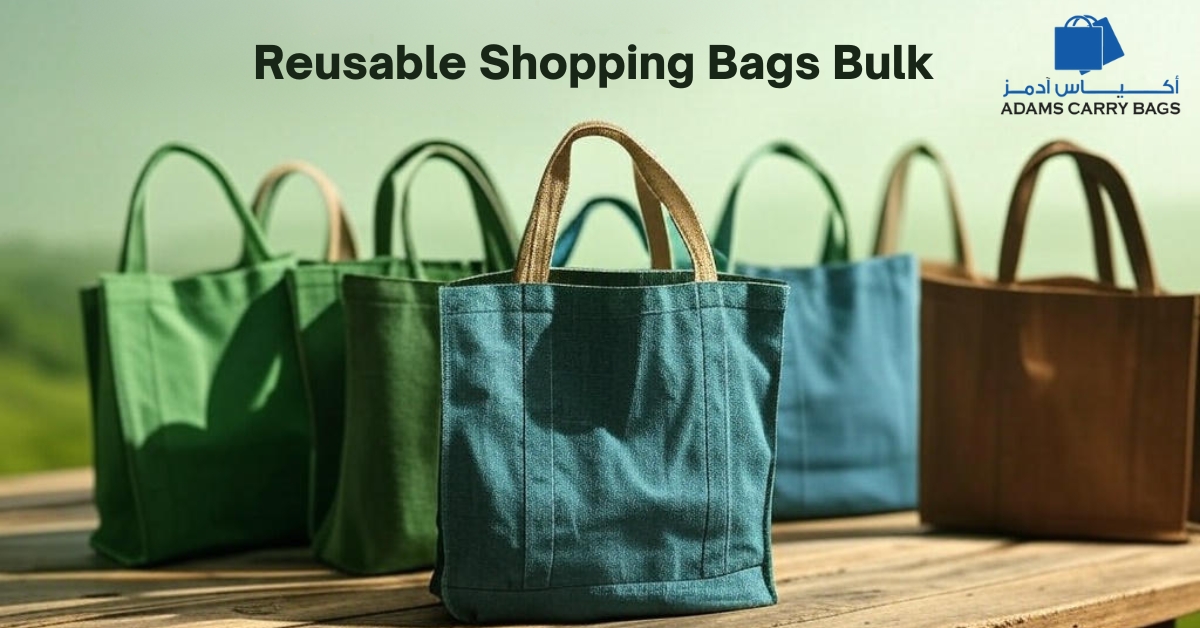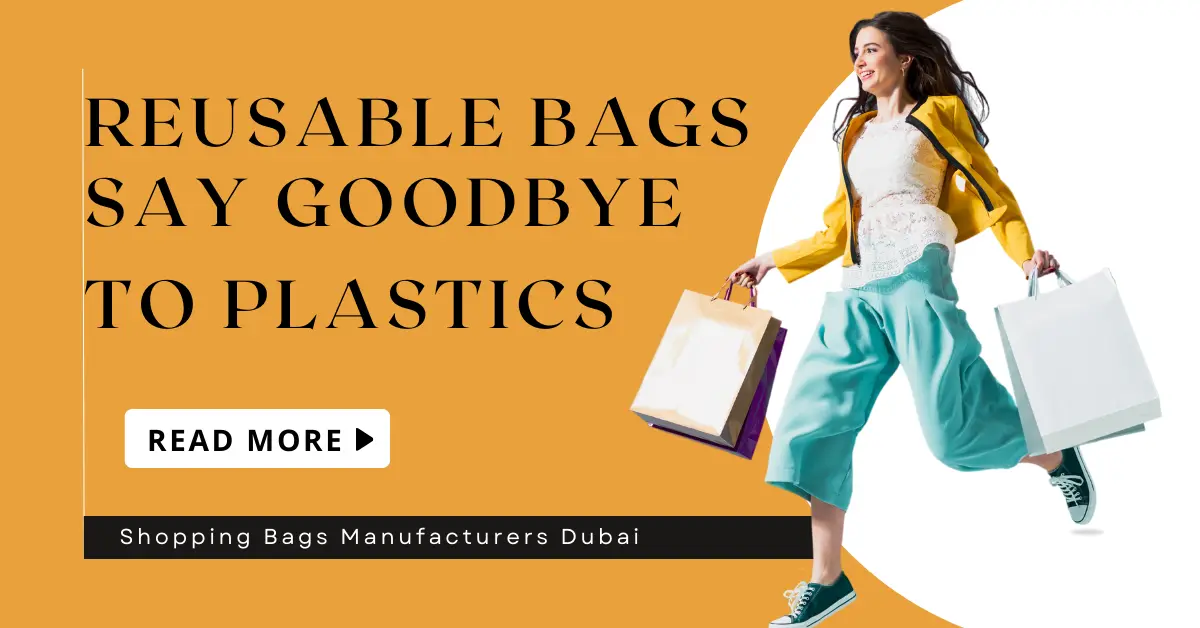
In recent years, there has been a significant shift towards ecofriendly products. As more people become aware of the environmental impact of single-use plastics, they’re seeking sustainable alternatives that don’t compromise convenience. This shift has given rise to a variety of reusable bags, with non woven grocery bags becoming particularly popular in places like Dubai, where both local businesses and consumers are embracing greener practices. Dubai’s rapid urbanization has brought with it a growing awareness of sustainability, and non-woven carry bags fit right into this ethos. These bags offer a practical way to reduce plastic waste, which is a significant contributor to pollution and environmental degradation.
But while reusable bags are gaining traction, it’s important to consider if they truly live up to the hype. Are they as ecofriendly as they seem? Do they offer the durability and versatility that justify their cost? In this blog, we’ll explore the benefits of non-woven carry bags, including their environmental impact, and discuss potential drawbacks that might arise with their increased use. We’ll also examine whether the investment in these bags is ultimately worthwhile, both from an economic and an ecological perspective. By the end, you should have a clearer understanding of the role these bags play in promoting sustainability and whether they’re the right choice for you or your business.
1.The Environmental Impact of Plastic Bags
Plastic bags have long been a staple in grocery stores and markets because they are cheap to produce and extremely convenient for consumers. However, their environmental impact is severe, with these bags often ending up as litter in landfills, rivers, and oceans, where they can take hundreds of years to decompose. As they slowly break down, they release microplastics into the environment, causing harm to marine life and potentially entering the human food chain. Additionally, plastic bags can cause serious harm to wildlife; sea turtles, for example, often mistake plastic bags for jellyfish and ingest them, leading to fatal blockages or other complications.
Switching to reusable bags helps combat this problem by dramatically reducing the number of single-use plastic bags that enter the waste stream. Non-woven carry bags, made from polypropylene, are designed to be used many times, providing a more sustainable option for shopping and carrying goods. Because they can be reused repeatedly, the need for single-use plastic bags is diminished, reducing the production of plastic and ultimately decreasing the volume of waste. This contributes to a cleaner environment and lessens the burden on our already stressed landfills and oceans.
Moreover, the switch to reusable bags sends a strong message about personal responsibility and environmental stewardship. By choosing reusable over plastic, individuals and businesses can actively participate in reducing pollution and promoting sustainability. It’s not just about the bags themselves—it’s about adopting a mindset that values durability, reusability, and a smaller environmental footprint. With every reusable bag used, there’s one less plastic bag contributing to pollution, leading to a ripple effect that benefits ecosystems, wildlife, and future generations.
2.Types of Reusable Bags
There are various types of reusable bags available on the market today, each with unique characteristics that cater to different needs and preferences. These bags range from simple cloth totes to more complex, engineered options like non-woven carry bags. Let’s take a closer look at some common types and explore what makes each of them special:
- Cotton Bags: Cotton bags are made from natural fibers, making them inherently ecofriendly and biodegradable. They are robust and can withstand a fair amount of wear and tear, which is why they are commonly used for shopping and carrying heavier items. Due to their natural composition, they are often favored by environmentally conscious consumers. Moreover, cotton bags are easy to customize, allowing businesses to print their logos or promotional messages, thus serving as walking billboards. Despite their durability, they require proper care to avoid shrinking and are less resistant to moisture compared to synthetic options.
- Jute Bags: Jute, sometimes called “the golden fiber,” is another natural material used to create reusable bags. These bags are valued for their sturdiness and rustic appearance. Jute bags are typically used for carrying groceries, as their woven structure provides a natural reinforcement for heavy loads. They are biodegradable and have a minimal environmental impact during production. However, jute bags can be less flexible in terms of design and are more susceptible to moisture damage, which can cause them to weaken over time.
- Polyester Bags: Polyester bags are made from synthetic fibers, offering a lightweight and durable alternative to natural fiber bags. They are water-resistant and easy to clean, making them an excellent choice for everyday use and outdoor activities. Because of their durability and flexibility, polyester bags are often used for promotional purposes, with companies printing vibrant designs to attract attention. However, since they are synthetic, they are not biodegradable and can contribute to environmental pollution if not properly recycled.
- Non-Woven Bags: Among the most popular types of reusable bags are non-woven carry bags, which are made from polypropylene, a synthetic polymer known for its strength and durability. These bags are lightweight, cost-effective, and designed to be reused many times, making them a practical choice for consumers and businesses alike. Non-woven bags can be easily customized with logos and branding, providing a versatile marketing tool for companies. While they are not biodegradable, their long lifespan helps offset their environmental impact. Proper recycling and reuse of these bags are key to maximizing their ecofriendly benefits.
In summary, the choice of reusable bags depends on various factors, including environmental considerations, durability, and intended use. While natural fiber bags like cotton and jute offer biodegradability, synthetic bags like polyester and non-woven carry bags provide greater versatility and resilience. Ultimately, the key to reducing waste and promoting sustainability lies in the repeated use and proper recycling of these bags, ensuring that they serve as a sustainable alternative to single-use plastic bags.
3.Benefits of Non-Woven Grocery Bags
Non-woven grocery bags offer a range of advantages over other types of reusable bags, combining durability, versatility, and affordability in a way that appeals to both consumers and businesses. Let’s delve deeper into the benefits that make these bags a popular choice:
- Durable: Non-woven material, typically made from polypropylene fibers, is known for its robustness. This makes it ideal for grocery shopping, where bags often carry heavy items like bottles, cans, and produce. The fabric’s inherent strength allows non-woven bags to maintain their shape even under significant weight, reducing the risk of tearing or damage. This durability translates into a longer lifespan for the bag, which means fewer replacements and less waste.
- Reusable: Unlike single-use plastic bags that are discarded after one use, non-woven bags are designed for repeated use. This reusability significantly reduces the number of plastic bags entering the environment, leading to a positive impact on pollution and resource conservation. It’s estimated that a single non-woven bag can replace hundreds of plastic bags over its lifetime, contributing to a more sustainable shopping experience.
- Ecofriendly: Although non-woven bags are made from synthetic materials, they are more environmentally friendly than single-use plastics because of their reusability. By using non-woven bags multiple times, consumers and businesses can significantly reduce their carbon footprint. Moreover, many manufacturers are exploring ways to produce non-woven bags with recycled materials, further enhancing their ecofriendly appeal. Proper disposal and recycling of these bags at the end of their lifecycle can also contribute to reducing environmental impact.
- Customizable: Non-woven carry bags offer businesses a unique opportunity for branding and promotion. These bags can be customized with company logos, slogans, or other designs, making them a powerful marketing tool. In Dubai and other regions, businesses often distribute custom non-woven bags at events, trade shows, or as promotional gifts, creating a lasting impression on customers. The ability to personalize these bags adds to their appeal, allowing companies to align their marketing strategies with sustainability goals.
- Affordable: Despite their durability and versatility, non-woven bags are relatively inexpensive to produce. This affordability makes them accessible to a wide range of consumers and businesses. The low cost, combined with their reusability, makes non-woven bags a cost-effective alternative to single-use plastics. Consumers save money by reusing these bags, while businesses can invest in them for promotional purposes without breaking the bank.
These advantages make non-woven grocery bags a practical and ecofriendly choice. Their combination of durability, reusability, Eco friendliness, customizability, and affordability makes them a versatile solution for reducing plastic waste and promoting sustainability. By choosing non-woven carry bags, consumers and businesses can take a significant step toward a greener future, one reusable bag at a time.
4.The Case for Investing in Reusable Bags
Investing in reusable bags can lead to both long-term financial savings and significant environmental benefits, making them a smart choice for individuals and businesses alike. Here’s a deeper look into why they are worth the investment:
- Cost-Effective: Although reusable bags typically have a higher upfront cost compared to single-use plastic bags, their reusability makes them far more cost-effective over time. Consumers can save money by reusing the same bags for grocery shopping, commuting, or other errands, eliminating the need to repeatedly purchase single-use bags. For businesses, particularly those in retail, offering reusable bags can reduce the expense associated with providing plastic bags to customers. This can also align with corporate social responsibility goals, ultimately boosting the brand’s reputation.
- Reduced Waste: By using non-woven carry bags, individuals and businesses can significantly cut down on the amount of plastic waste they generate. This reduction in plastic waste has a ripple effect, leading to less plastic pollution in landfills and natural environments. Since single-use plastic bags often end up as litter or in oceans, replacing them with reusable bags is a critical step in combating environmental pollution. The reduced waste also means fewer resources are consumed in the production of disposable bags, contributing to a more sustainable approach to manufacturing.
- Brand Promotion: Businesses in Dubai and other regions can use non-woven carry bags as an effective marketing tool. These bags offer a unique opportunity for companies to increase brand visibility by printing logos, slogans, or other promotional designs. Unlike traditional advertising methods, reusable bags are mobile, allowing businesses to reach a wider audience as customers carry them around. This form of marketing is also ecofriendly, as it reduces the need for disposable promotional materials like flyers or brochures, aligning with a company’s sustainability goals.
- Supporting Ecofriendly Practices: Investing in reusable bags sends a powerful message about supporting sustainable and ecofriendly practices. When individuals opt for reusable bags, they demonstrate a commitment to reducing their environmental impact. This mindset shift can influence others, encouraging more people to adopt similar habits. For businesses, promoting reusable bags can showcase their dedication to sustainability, which can resonate with environmentally conscious consumers. This commitment can lead to increased customer loyalty and attract new customers who prioritize ecofriendly practices.
By investing in reusable bags, both individuals and businesses can make a tangible difference in reducing waste and promoting sustainability. The long-term cost savings, combined with the environmental benefits, make these bags a worthwhile investment. Moreover, businesses can leverage the marketing potential of customized reusable bags, reinforcing their brand while contributing to a cleaner planet. Ultimately, reusable bags represent a simple yet impactful way to create positive change and build a more sustainable future.
5.How Reusable Bags Are Made
To understand the value of non-woven grocery bags, it’s important to know how they are made. The manufacturing process is complex and involves several key steps, each contributing to the final product’s durability, versatility, and customization potential. Here’s a detailed breakdown of the manufacturing process:
- Material Selection: The foundation of non-woven bags is polypropylene, a synthetic polymer known for its strength and light weight. This material is chosen because it balances durability with flexibility, allowing manufacturers to create bags that are both robust and easy to carry. The polypropylene used in these bags is typically sourced from recycled plastics, which contributes to the ecofriendly aspect of non-woven bags. The use of recycled materials not only reduces waste but also lowers the carbon footprint associated with production.
- Fiber Bonding: Once the polypropylene is selected, the fibers are bonded together through a process that uses heat, pressure, or chemicals to create a cohesive fabric. This step is crucial, as it determines the bag’s strength and flexibility. The resulting non-woven fabric is designed to be strong enough to withstand heavy loads while remaining lightweight and easy to handle. The fiber bonding process also allows for varying thicknesses, giving manufacturers the flexibility to create bags with different levels of durability and texture.
- Cutting and Sewing: After the non-woven fabric is created, it’s cut into specific shapes and sizes based on the bag’s intended design. This is where the customization begins, as manufacturers can create bags in various styles, from simple totes to more complex designs with zippers, pockets, and handles. The sewing process is critical to ensure the bags are properly assembled and can endure regular use. Skilled workers use specialized sewing machines to stitch the fabric together, ensuring strong seams and durable construction.
- Printing and Design: The customization process doesn’t end with cutting and sewing. Non-woven bags are often used for promotional purposes, so businesses and organizations can print logos, designs, or other graphics on the bags. This is done using a variety of printing techniques, such as screen printing or heat transfer, depending on the desired design’s complexity and color requirements. The ability to customize non-woven bags makes them popular for branding and marketing, allowing companies to create eye-catching designs that resonate with customers.
- Quality Control: Before the bags are distributed to retailers or customers, they undergo rigorous quality control. This step ensures that each bag meets the required standards for durability, strength, and safety. Quality control involves inspecting the bags for defects, checking seams and stitching, and testing the bag’s ability to carry heavy loads. This meticulous process is essential to ensure that non-woven grocery bags can withstand the rigors of everyday use without tearing or breaking.
By understanding the manufacturing process for non-woven grocery bags, we can appreciate the level of craftsmanship and attention to detail that goes into creating these ecofriendly and durable products. The combination of recycled materials, robust bonding techniques, customization options, and stringent quality control makes non-woven bags a practical and sustainable choice for consumers and businesses alike. This comprehensive manufacturing process ensures that non-woven bags meet the demands of today’s environmentally conscious market, providing a viable alternative to single-use plastics.
6.The Durability and Versatility of Non-Woven Bags
One of the key reasons non-woven carry bags are worth the investment is their impressive durability and versatility. Unlike traditional plastic bags, which are often single-use and prone to tearing, these bags are designed to endure heavy loads and repeated use. This makes them particularly suitable for a range of daily activities, from grocery shopping to carrying books, and even as versatile travel bags for weekend trips or gym visits.
The durability of non-woven carry bags comes from the unique structure of their material. Made from polypropylene fibers that are bonded together through heat or pressure, these bags are strong yet flexible, allowing them to carry a variety of items without breaking or stretching out of shape. This robustness makes them a popular choice among consumers who are looking for a sustainable alternative to plastic bags that won’t compromise on strength or reliability.
Moreover, the versatility of these bags extends far beyond their durability. Non-woven bags can be customized in terms of color, size, and shape, offering a wide array of design options. This adaptability makes them suitable for various purposes. For example, businesses in Dubai and other regions can tailor the bags to fit their branding needs, choosing colors that align with their company logo or creating unique shapes that distinguish their products from the competition.
Customization isn’t just about aesthetics; it’s also about functionality. Non-woven carry bags can be designed with additional features like extra pockets, reinforced handles, or even zippered compartments, making them more useful for specific tasks. This flexibility is particularly valuable for businesses that use these bags for marketing and promotional activities. A well-designed non-woven bag can serve as a walking advertisement, with customers carrying the bag throughout the city, thereby increasing brand visibility.
In Dubai, where sustainability is becoming increasingly important, the versatility of non-woven bags has made them a popular choice for businesses looking to reduce their environmental impact while still engaging with customers. Companies can use these bags as promotional items at events, trade shows, or product launches, providing a practical and eco-friendly gift that customers are likely to reuse. This not only helps to promote the business but also aligns with broader sustainability goals.
In summary, the durability and versatility of non-woven carry bags make them a worthwhile investment for both consumers and businesses. They offer a sustainable and customizable alternative to traditional plastic bags, with the added benefit of serving as effective marketing tools. Whether used for daily errands or business promotions, these bags represent a practical step towards a more eco-friendly and sustainable future.
7.Dubai’s Approach to Sustainability and Reusable Bags
Dubai has become a hub for sustainability and ecofriendly practices, leading the charge in the Middle East for innovative approaches to reducing plastic waste. The city has implemented a range of initiatives designed to limit the use of single-use plastics and promote the adoption of reusable bags. Here’s a deeper look at how Dubai is setting an example for sustainability:
- Plastic Bag Bans: Recognizing the detrimental impact of plastic waste on the environment, Dubai has taken proactive steps to limit the use of single-use plastic bags. By introducing regulations that restrict the distribution of plastic bags in supermarkets and retail stores, the city has created a shift in consumer behavior. This move has encouraged businesses to offer alternatives such as non-woven carry bags, and it has inspired consumers to adopt reusable options. The ban not only reduces the number of plastic bags in circulation but also raises awareness about the importance of sustainability.
- Public Awareness Campaigns: Dubai understands that regulations alone are not enough to change habits; public awareness and education are key to fostering a culture of sustainability. The city has launched several campaigns to educate the public about the environmental benefits of using reusable bags. These campaigns include informative ads, community workshops, and school programs designed to engage people of all ages. By highlighting the impact of plastic waste on marine life and the broader ecosystem, Dubai’s public awareness campaigns are helping to shift societal attitudes toward more ecofriendly practices.
- Business Incentives: To encourage businesses to embrace sustainability, Dubai has introduced incentives for adopting ecofriendly practices. These incentives include tax breaks, reduced fees, and public recognition for companies that demonstrate a commitment to reducing plastic waste. By offering these incentives, Dubai has seen a noticeable increase in the use of non-woven carry bags and other reusable options throughout the city. This approach not only motivates businesses to reduce their environmental footprint but also fosters a sense of community responsibility, as companies become ambassadors for sustainability.
These initiatives have positioned Dubai as a leader in sustainability and ecofriendly practices in the region. The city’s comprehensive approach—combining regulation, education, and incentives—has created a ripple effect that extends beyond its borders. Dubai’s efforts are inspiring other cities and regions to consider similar approaches to plastic waste reduction and sustainability.
By encouraging the use of reusable bags, Dubai is not only reducing plastic pollution but also promoting a shift in consumer behavior that aligns with a greener future. This approach reflects the city’s broader commitment to sustainability, from its ambitious green building projects to its investment in renewable energy sources. As Dubai continues to grow and evolve, its emphasis on ecofriendly practices is likely to influence other cities to follow suit, creating a more sustainable world for generations to come.
8.The Role of Innovation in Reusable Bags
Innovation plays a pivotal role in the development of high-quality reusable bags, as manufacturers continually seek new materials and techniques to enhance their durability, functionality, and Eco friendliness. This drive for innovation reflects a growing demand for sustainable products and a desire to reduce reliance on single-use plastics. Let’s explore some of the latest trends and advancements in the production of reusable bags:
- Biodegradable Materials: Although non-woven bags are prized for their durability and versatility, they are typically not biodegradable. To address this, some manufacturers are experimenting with new materials that break down more quickly in the environment. These biodegradable materials, such as plant-based polymers or blends of natural and synthetic fibers, are designed to offer the same strength and reusability as traditional non-woven bags while being more ecofriendly. The goal is to create reusable bags that can eventually decompose without leaving behind harmful microplastics or other pollutants.
- Smart Features: As technology continues to evolve, manufacturers are incorporating smart features into reusable bags to add functionality and appeal. For example, some innovative bags include RFID tags, allowing for easy tracking and inventory management. This technology can be particularly useful for businesses that distribute promotional reusable bags, as it provides data on where the bags are being used and by whom. Other smart features include built-in charging ports for electronic devices, insulated compartments for food or drinks, and adjustable straps for increased comfort.
- Sustainability in Manufacturing: Beyond the bags themselves, manufacturers are increasingly focusing on sustainability throughout the entire production process. This includes reducing waste, minimizing energy consumption, and using environmentally friendly practices. For instance, some manufacturers are adopting closed-loop systems, where excess materials and scrap are recycled back into the production process. Others are investing in renewable energy sources to power their facilities, reducing their carbon footprint. Additionally, manufacturers are seeking certifications for sustainable practices, such as ISO 14001, to demonstrate their commitment to environmental responsibility.
Innovation in reusable bags extends to design and aesthetics as well. Manufacturers are exploring new patterns, colors, and textures to make reusable bags more attractive to consumers. This focus on design not only enhances the visual appeal of the bags but also encourages people to use them more frequently, thereby reducing the need for single-use plastic bags.
In summary, innovation is driving the development of reusable bags in exciting new directions. By exploring biodegradable materials, incorporating smart features, and prioritizing sustainability in manufacturing, companies are creating bags that are not only functional and durable but also more environmentally friendly. These trends reflect a broader shift toward sustainability and a growing recognition that small changes, like choosing reusable over disposable, can have a significant impact on the planet. As technology and environmental awareness continue to evolve, the future of reusable bags looks increasingly promising.
9.Are Reusable Bags Really Ecofriendly?
One of the common questions about reusable bags is whether they are genuinely ecofriendly. While they represent a significant improvement over single-use plastic bags, they are not without their own environmental impact. The production of polypropylene, the primary material for many non-woven bags, involves energy-intensive processes and the use of raw materials derived from petroleum. This means that although these bags are more durable and reusable, their manufacturing contributes to carbon emissions and resource depletion.
However, the environmental benefits of reusable bags lie in their reusability. When used as intended, a single non woven grocery bag can replace hundreds, if not thousands, of single-use plastic bags over its lifespan, significantly reducing overall waste. This repeated use helps offset the initial environmental cost of production, making the case for reusable bags as a more sustainable alternative. The key to achieving this sustainability is to ensure that these bags are used repeatedly and not discarded after only a few uses.
To further improve the Eco friendliness of reusable bags, manufacturers and consumers are turning to recycling programs. At the end of their useful life, non-woven bags can be recycled and repurposed into new products, reducing the need for virgin materials and minimizing waste. These recycling programs are becoming more common as awareness of sustainability grows. By participating in such programs, consumers and businesses can contribute to a circular economy, where materials are continuously reused and repurposed, rather than being discarded.
Additionally, some manufacturers are exploring ways to make non-woven bags more ecofriendly by using recycled polypropylene or blending synthetic fibers with natural, biodegradable materials. These efforts aim to reduce the environmental impact of production while maintaining the durability and versatility that make reusable bags appealing in the first place.
To ensure that reusable bags remain ecofriendly, it’s crucial to use them as intended and dispose of them properly. Consumers can maximize the sustainability of these bags by reusing them for shopping, travel, or other purposes, and then recycling them when they are no longer usable. Businesses can play a role by encouraging customers to bring their own reusable bags and offering recycling programs for worn-out bags.
Ultimately, while reusable bags do have some environmental impact, their potential for reducing waste and promoting sustainability is significant. By using them repeatedly and recycling them at the end of their lifespan, we can contribute to a cleaner, more sustainable future. The journey toward a greener world requires ongoing effort, and reusable bags are a step in the right direction, demonstrating that small changes in daily habits can make a big difference in the fight against plastic pollution.
10.Are Reusable Bags Worth the Investment?
In summary, reusable bags offer numerous benefits that make them a smart investment for both individuals and businesses. These bags, especially non-woven carry bags, are designed to be durable, ecofriendly, and cost-effective over the long term. By opting for reusable bags, you can contribute to reducing plastic waste and promoting sustainability, which is increasingly important in our fight against environmental degradation.
In cities like Dubai, where environmental consciousness is on the rise, the use of reusable bags is gaining traction. Through a combination of regulations that limit single-use plastics and public awareness campaigns that highlight the benefits of reusable options, Dubai is creating a culture that prioritizes sustainability. This environment provides businesses with unique opportunities to leverage non-woven carry bags for promotional purposes. Companies can customize these bags with their logos or branding, turning them into walking advertisements that resonate with eco-conscious consumers.
To ensure that reusable bags remain ecofriendly, it’s essential to use them repeatedly. A single non woven grocery bag can replace hundreds of plastic bags over its lifespan, greatly reducing waste. This reusability not only lowers the environmental impact but also translates into long-term cost savings for consumers who no longer need to purchase disposable bags. Additionally, recycling programs are becoming more common, allowing for responsible disposal and repurposing of these bags once they have reached the end of their useful life.
By reusing and recycling non-woven carry bags, you can make a positive impact on the environment while enjoying their durability and versatility. Whether you’re using them for grocery shopping, travel, or promotional purposes, these bags offer a sustainable alternative to single-use plastics. Ultimately, reusable bags represent a small investment with a significant return, both financially and environmentally.
As we move toward a more sustainable future, every small step counts. By choosing reusable bags, you’re taking a tangible action to reduce waste and promote a cleaner, greener world. It’s a simple yet effective way to demonstrate your commitment to sustainability, and it can inspire others to do the same. With each reusable bag, we’re making a difference—one bag at a time.





